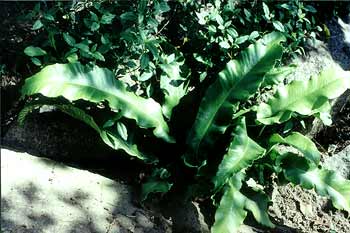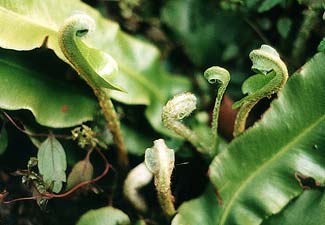 Hart's Tongue Fern
Hart's Tongue Fern
"To my freedom, chafe at Fate,
Till the happier elves I hate,
Who in moonlight dances turn
Underneath the palmy fern."
-Bayard Taylor
1825-1878
1825-1878
I was amused to see that the commercially prepared color-illustration tag that came with this fern named it a "Heart's Tongue Fern" which illicited an image of a surgeon removing a throbbing heart which blows raspberries at the doctor with its long tongue hanging out. Of course it isn't a heart, but a Hart, or deer, that is implied (less grotesquely but still amusingly) to have a green tongue.
We planted this Asplenium scolopendrium americana (aka Phyllitis scolopendrium) in a crack between a cliff-face's stone & the concrete stairway down from the front yard, where it is very near some western swordferns. It may seem a bit pinched between it's rock & a hard place, but in nature they are fond of popping up at the foot of fresh landslide areas where they thrive amidst whatever loose rocks have roled under deciduous trees, likewise in limestone crevices, damp woods with limestone derived soil, & around the mouths of caves; so really this stony wall is as close to its wild prefrence as I could provide for it. It is the only fern in this garden that doesn't prefer somewhat acidic soil, so I've used a little fireplace ash worked into the ground around its immediate vicinity hoping this will meet its limestone soil requirement, besides whatever good being against a concrete stair might do for the same need.
 Hart's-Tongue Fern has slightly leathery very glossy undivided leaves, not very fern-like as ferns go. During its short life it is an evergreen. But I was warned that it will in its second summer undergo fructification, then die the following spring at the beginning of its third year. When it is gone, if it fails to return through its own spoors, I will miss it.
Hart's-Tongue Fern has slightly leathery very glossy undivided leaves, not very fern-like as ferns go. During its short life it is an evergreen. But I was warned that it will in its second summer undergo fructification, then die the following spring at the beginning of its third year. When it is gone, if it fails to return through its own spoors, I will miss it.The photo above was taken in autumn; it made it through the winter only a little worse for wear. The ground cover plant behind the hart's-tongue has wiry fine stems & tiny green leaves. It can be seen in bloom on the Creeping Veronica page. The second Harts Tongue photo shows it the following April with fiddleheads erupting amidst the old leaves.
This fern was once very common in cool or elevated regions all across North America, but is vanishing over much of its American range because it is too sensitive to the changes man inflicts on the forests. As it is protected in some of its North American range, specimens on the market are generally cultivated by nurseries, but some pressures from wild collecting do remain. It's nearly identical European mate is not so much at risk but has been noted also to have vanished from some areas of its extensive range because of habitat loss & from gardeners' fondness for taking them home from the woods.
The Latin species name scolopendrium means "centipede" so-called because when it develops spores, if you look at the underside of the leaves, you will see a cinnamon-colored centipede pattern. Asplenium refers to an old superstitious belief that it has medicinal value in treating the spleen, thus has been known as spleenwort or even lungwort. Its previous name Phyllitis is Greek for leafy, underscoring its leaf unique among ferns.